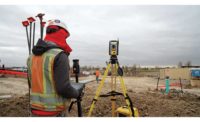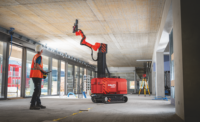Mobile BIM Viewer Brings the Model to Trades on Site

The Procore BIM viewer can switch between 2D plans and the full 3D model, allowing for simple fly-throughs with only a few taps.
Image Courtesy of Procore
Getting BIM models to the field on mobile platforms has hit some speed bumps in the past, but a new BIM viewer from Procore is the latest attempt to put full 3D building models in the hands of site workers.
Working with complex BIM files, engineers and architects develop a coherent, information-dense digital version of the structures they plan to build. But getting the information in that model to the workers on the site is a challenge.
Some sites might have a laptop in a gang box every few floors so supervisors can double-check plans, or mobile apps that display 2D plans taken off of 3D models. But specialty contractors might later discover problems on site that were not taken into account, and communications breakdowns are common when one side is looking at the BIM and another at 2D plans on site.
“The biggest problem with any document is getting it out of the office to the field in real time,” says Howard Simble, senior MEP superintendent with Robins & Morton. Simble oversees MEP installations on large healthcare projects, where sequencing issues and minor changes in design can lead to costly delays. “We’ll be huddled around an information station with a model we can look at briefly. It’s all very cumbersome to get that information to the field.”
Simble has tried out several mobile-based BIM viewers, and has been disappointed by them all so far. But after spending some time with a pre-release version of the Procore viewer, he’s coming around on what it can bring to the site.
Procore’s BIM viewer is designed for fly-throughs of the model, and the initial version does not support markups or annotations. But the model in the viewer is the complete BIM file, and different elements can be turned on or off so specific trades can look at the work they will be performing. It does not require a wireless connection to work, a useful feature on jobsites where finding a good signal can be a problem.
“We’re taking the full 3D model—the BIM relegated to VDC managers—and giving field workers access to that on an iPad,” explains Dave McCool, senior product manager at Procore. “But performance and navigation are key: if it doesn’t load fast, or is not easy to navigate, the 2D drawings will always win.”
Rather than try to pack in a full BIM environment with all the features of desktop software, McCool says the Procore team went for a stripped-down viewer that users can pull out and check with a few taps.
“We had to limit the feature set, we questioned every feature request that VDCs were making for the app,” recalls McCool. “We’re building this for boots on the ground, the trades…we’re trying to keep the navigation intuitive and simple.”
In order to use the viewer, 2D drawings are mapped to the model floor-by-floor, with gridlines and scaling set by the user. This allows for the mobile app to quickly transition from 2D to the BIM model, with virtual walkthroughs using simple navigation controls.
The BIM viewer is currently only available on Apple devices, and is built with iPads in mind. Procore worked with Apple’s iPad team on how to get the most out of its Metal graphics framework to improve performance of the viewer on newer iPads.
For Simble, the fast-response of the Procore viewer was the deciding factor. “The full Procore [software] isn’t comfortable on an iPad for someone in the specialty trades,” he says. “But being able to stand in a building and look at the model directly, that’s a big deal.”
Disconnect between BIM models overseen by VDC managers and the 2D drawings that MEP trades have on site is a major source of headaches for Simble. “The whole thing in MEP is ‘just give me the drawings,’ and if it’s all correct they get along fine. But if they just have drawings you usually find problems when you are installing the equipment,” he says. “So back these guys up a bit, get them on iPads and get on the models early, turn things on and off and fly through it. You’ll see those problems a lot earlier.”
Simble doesn’t expect the Procore BIM app will solve every problem on the site, but getting workers on the site to spend time in the model that other project team members worked on might change things. “It really helps when they look at it, see it’s the same thing our people built. It takes away that attitude that ‘BIM sucks, it’s all the fault of architects and engineers for complicating everything,’” he says.
“This is about coordination. Procore is doing something no one else is doing right now.”



